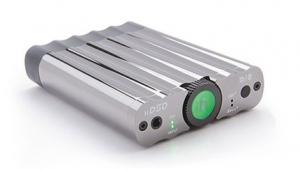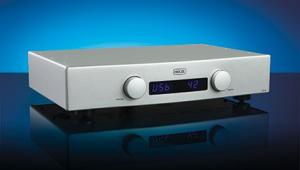Chord Electronics Hugo - £1,400

For this writer, one of the most disappointing things about digital audio – and especially CD’s 16/44.1 specification where the problem seems most acute – is its timing. It just doesn’t quite seem to accurately reproduce all the nuances you hear in music when listening in real time. The major issue to my ears is that if you go to a jazz club to hear Randy Crawford sing, then come back home and play the CD the digital disc just doesn’t have the natural ebb and flow of the live concert.
In this respect, vinyl LPs do better. Sure, they have a multitude of other problems, but always seem to time more convincingly when played on a decent turntable. The reason for this, according to Chord Electronics designer Rob Watts, is that digital audio is fundamentally constrained by (what, if it were a television you’d call) its frame rate. Because it has a limited number of samples (‘frames’) per second, it can’t completely accurately resolve the ‘inter-aural’ timing of the music. Watts thinks this is a serious flaw, and the lower resolution the digital signal is (ie CD compared to hi-res), the more acute the problem becomes.
Rob isn’t a digital audio engineer by training, this discipline was in its infancy when he studied electronics engineering at Cardiff, back in the eighties before co-founding DPA. He also researched pyschoacoustics, and this has stood him in great stead for what he is doing now. All his designs – from the early DPA Enlightenment DACs of the nineties to the ground-breaking Chord DAC64 – have shown an understanding for the problems of digital audio that go beyond simple considerations of frequency domain distortion. Rob says that – in simple terms – the brain samples sound in real time every 4 microseconds, whereas CD refreshes its ‘frames’ every 22 microseconds. It’s CD’s inability to work as fast as the brain that causes its problems in the time domain, why it doesn’t sound natural. And the unique design of the Hugo DAC addresses precisely this failing.
He contends that conventional digital filters don’t have the ability to properly resolve musical transients. Their poor ‘frame rate’ effectively chops off the leading edges of some notes, meaning the brain can’t recognise them as music in the way it does when hearing it live. His Watts Transient Aligned digital filter is designed to address this, by sampling the ‘frames’ faster than usual and interpolating the values for the lost ‘frames’ in-between the captured ones. This is done using a huge Xilinx Field Programmable Gate Array, rather than off-the-shelf chips from existing manufacturers. Using an FPGA lets Rob write his own code for the WTA digital filter, and those in the Hugo are more sophisticated than any that have come before because of the vast number of gates the new FPGA has. He’s worked in a digital filter with a far higher tap-length than that seen in stock DAC chips – 26,000 in the Hugo compared with the approximately 150 in standard DACs.
For this reason, the Hugo should sound different to every other DAC around. The Xilinx FPGA also has another trick up its sleeve. It consumes just 0.7V of power, which is dramatically lower than older such devices. This has made the idea of an ultra high-quality portable, battery powered DAC possible – and Chord ran with it. Indeed it’s a double win, because you get the sound quality benefits conferred by not having an AC mains transformer throwing noise into the DAC, and also the portability benefits too. The Hugo can be used everywhere. I’ve even plugged it into the auxiliary inputs of my Nakamichi car system and used my Sony Xperia Z phone as a Bluetooth source! The brilliant thing about the Hugo is that the same FPGA that gives it its special sound, also makes it the most handy DAC you could ever own.
Chord hasn’t stopped there. The DAC supports PCM formats up to 384kHz including DXD and will natively play DSD64 and DSD128 in DoP format. It also has a very high-quality digital volume control and the choice to run the Hugo as a line-level device like a normal DAC. It has headphone and RCA phono outputs, plus USB, optical and coaxial digital inputs, and aptX Bluetooth. All of these functions are controlled by small unlabelled buttons on the body, while inside the unit’s large lens, LEDs light up in different colours to indicate source selected, battery charge status and Crossfeed setting. There’s also another separate lens that shows – by different colours – the sampling frequency. It’s all quite confusing at first, but perseverance pays off and you’ll begin to find it a very intuitive little gizmo.
Sound quality
I review a lot of fine hi-fi, but it’s very rare to come across something quite as special as this. The Hugo has an ease, a fluidity and a naturalness that’s unique; as far as its ability to make music flow in an organically enjoyable way, I’ve heard nothing quite like it.
Anyone that has owned a Chord DAC64, QBD76 or Qute will know what I’m talking about, as there’s something about these (other Rob Watts) designs that seems to go beyond what’s normally expected of digital. The Hugo goes further still, and the difference is centred around the way the music flows. It simply doesn’t time like others, it presents the music in an organic way that you don’t equate with digital. The improvement is most obvious on 16/44 (ie CD), where the filtering papers over the cracks that aren’t as obvious with higher-resolution music, but you’ll hear it everywhere.
Put on simple female vocals such as Kate Bush on Oh England, My Lionheart through a good conventional DAC and you’ll get a decently warm, fulsome performance that sounds impressive in hi-fi terms. But through the Hugo you’re pulled into the music as it mesmerises you. You become far less interested in the hi-fi aspects of the performance, and drawn like a moth to a flame, right into the song. It’s only when it’s finished that you realise the soundstaging was superb, the detail resolution amazing and the tonal balance silky smooth. It pulls this trick off again and again.
Play REM’s Welcome To The Occupation, for example, and suddenly you’re drawn into the music’s natural groove. The band’s playing is so beautifully syncopated with one another and the Hugo shows this to you like no other DAC I’ve yet heard. It’s like it has a sixth sense.
It is impressive in hi-fi terms too; bass is powerful yet wonderfully supple, bouncing up and down like a giant rubber ball. The midband is startlingly open and detailed, and soundstaging is sublime. Able to lock individual elements in the mix in space like they’d been etched into granite by a laser, it reminds me of studio-quality analogue open-reel tape in this respect. Even on older low-fi recordings – like ELO’s Turn To Stone – you can hear Geoff Lynne’s vocals bouncing off the four walls of the studio vocal booth, and this is completely independent of the umpteen channels of guitars, drums, strings, etc also going on in the mix. At the same time his voice drips with harmonics that you normally don’t hear with CD, these coming to the fore because it feels like a layer of distortion has been washed away – it’s like someone’s wiped the CD lens clean. Treble is on another level too. The Hugo doesn’t sound bright, but when there’s a hi-hat crash it resounds around, sparkling pristinely and then seemingly taking twice as long to decay as you’d expect. This is the sort of trick I’ve only heard from high-end vinyl tracking super-expensive moving coil cartridges, or the best dCS digital converters costing 10 times the price of the Hugo.
Cue up Beethoven’s Pastoral Symphony on CD and you can hear so much air and space to the music that you think you’re listening to a 24/192 hi-res file. It’s all so smooth, open and airy, yet this high-resolution sound is so brilliantly integrated. Unlike a number of multi-thousand pound DACs I’ve heard, it doesn’t just do detail, rather it strings everything together in a most convincing way. It’s so expressive and emotive you wonder why you ever doubted CD. And running the gamut of hi-res options the Hugo offers, things get better. DSD via the USB input is breathtaking, giving an icily clean and pristine sound yet it simply isn’t recognisable as digital. 24/96 PCM via FLAC is most people’s idea of hi-res, and this too is a joy. I’ve never heard Wings’ Band On The Run sound quite so lifelike before. The really fascinating thing, though, is what it does to decidedly lo-fi music files, like a 192kbps MP3 of Daft Punk’s Get Lucky. I’ve played this file across a multitude of DACs over the past year or so and never heard it sound so musically satisfying before; indeed it seems better than most other DACs playing the CD!
Conclusion
In the Hugo, Chord Electronics has made one of the finest digital converters in the world – and it just happens to be portable. It works brilliantly as a fixed-level output DAC, but has an excellent digital volume control that can drive a power amplifier with ease, and is also great powering a good set of headphones. This is a landmark product because it makes all flavours of digital sound so nice to listen to. And as many of my fellow vinyl aficionados will agree, that takes some doing.
LIKE: Supremely natural, open sound; portability; flexibility
DISLIKE: Halts the vinyl revival in its tracks
WE SAY: Nothing less than a landmark digital product
DETAILS
PRODUCT Chord Electronics Hugo
ORIGIN UK
TYPE DAC/headphone amplifier
WEIGHT 0.4kg
DIMENSIONS (WxHxD) 100 x 20 x 132mm
FEATURES
• 32-bit/384kHz, DXD, DSD64, DSD128
• aptX Bluetooth, optical, coaxial, 2x USB inputs
• 6.3mm and 3.5mm headphone, RCA phono outputs
• Rechargeable battery operation
• Volume/output level control
DISTRIBUTOR Chord Electronics Ltd
TELEPHONE 01622 721444
WEBSITE chordelectronics.co.uk
 |
Inside this month's issue:
Q Acoustics 3020c standmount loudspeakers, Perlisten R10s active subwoofer, Quad 33 and 303 pre/power amps, Acoustic Solid Vintage Full Exclusive turntable, newcomer Fell Audio Fell Amp and Fell Disc and lots, lots more...
|




















































